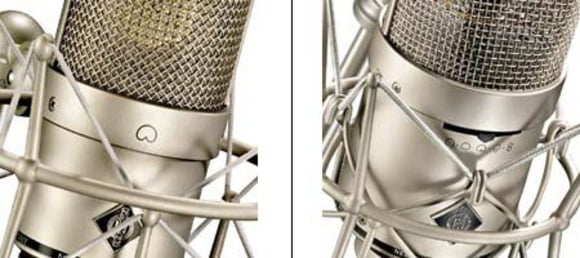7. Directional Patterns
(Fixed) Cardioid Pattern
Large diaphragm condensers can either have one fixed directional pattern or they can be multipattern microphones. LDs with a fixed pattern almost always have a cardioid shaped pick-up pattern. Some have a slightly narrower or wider pattern such as hypercardioid or wide cardioid. Fixed omni LD condensers are very rare and mainly geared toward orchestral recordings.
In pop music, cardioid is by far the most widely used pick-up pattern. Cardioid mics pick up sources in front (on axis) of them louder than sound coming from the sides (off axis). Sound from the rear (180 degrees off the recording axis) is rejected the most. Thats exactly what we need for a punchy pop sound. We get a lot of direct signal and only a small amount of room reflections. You can also use the cardioid pattern to suppress unwanted sound, computer noise, for instance. Just position the mic so the rear faces your computer or whatever noise source.
Multipattern
Even though cardioid is the best pattern for about 80 percent of studio applications, other patterns do get their use. A multipattern LD condenser lets you dial in any pattern at the flip of a switch. Very cool!
Omni Omnidirectional pattern means, sound is picked up equally loud from all sides. Omni pattern is excellent for recording choirs and vocal groups. Just gather the singers around the mic. Make loud singer step back a little and move soft singers a little closer to the mic. Omni pattern gives a very natural sound that also makes for great recordings of acoustic instruments.
Figure-of-eight Figure 8 means the microphone is sensitive to front and back but rejects sound from the sides. You can use the figure 8 pattern for recording two singers simultaneously. Oftentimes, such a performance sounds more engaging than recording the singers separately. But figure 8 also comes in handy for recording just one singer. Figure 8 produces a very strong proximity effect, i.e. the bass becomes very fat and prominent when you sing up close. Figure 8, thus, is ideal for recording small-chested singers. It makes them sound big and powerful.
Figure 8 is also needed for recording in M/S-Stereo technique. The mid microphone, that faces the source directly, can have any pattern (usually cardioid), but the sides microphone that is positioned in a right angle to the M-microphone and faces the sides (hence the name), must be figure 8. Mid/side signals have to be decoded into a normal left/right signal using an M/S matrix. Some newer microphone preamps include such a matrix, but there are also software decoders. One of the great things about M/S technique is that it produces stereo recordings that are fully mono compatible.
But theres yet another use for multipattern condensers. You can use the pattern switch as a kind of natural equaliser, especially when working with vocalists. On most multipattern mics, the sound changes quite dramatically as you go through the various patterns. Omni usually sounds bright, cardioid more balanced, and figure 8 sounds fat and dark. Many multipattern mics have in between positions, which allow you to tweak the sound to taste.


